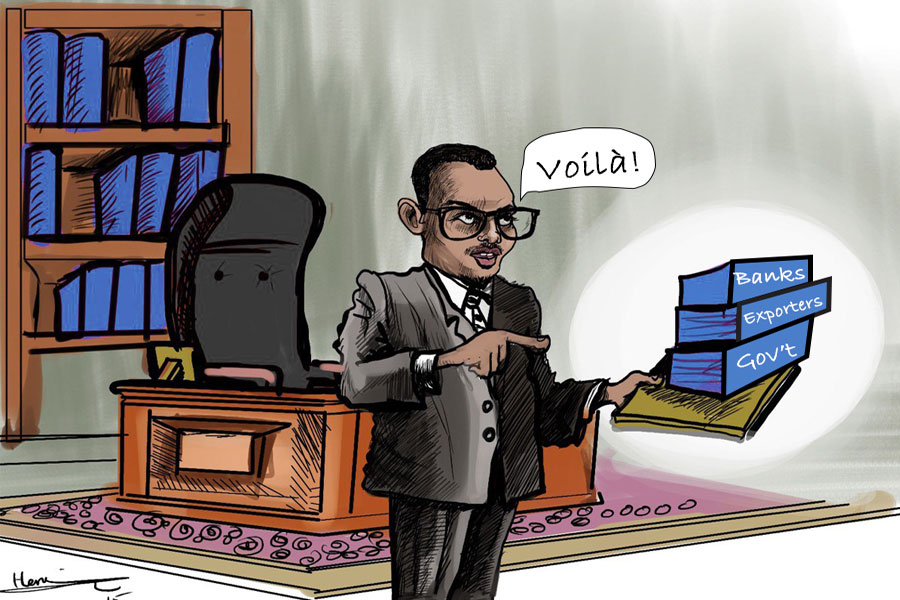
In-Picture | Mar 16,2024
Last week came and passed swiftly, unusual for the weeks I was used to for as long as I remember. It looked at times like coming out triumphant from addiction, while at times, it seemed like merely succumbing to a new brand of narcotic. I was arguing with myself whether it was a routine per se, as it entailed nothing other than only going to a theatre but at increasingly higher rates.
I believed it was time to face up to one of my New Year’s resolutions to attend art and creative endeavours in Addis Abeba, especially each and every theatre show, and write a note of my impression on the same. At the same time, I was consciously attempting to distance myself from digital gadgets – thus, going into the internet at the least and avoiding screen time altogether at the most. There was nothing better to help with my resolution than a feast of theatre at the historical Hager Fikir Theatre.
The shows at the theatre (and the National Theatre) were, “Latew bale Tidar,” “Yegna Sefer,” “Gazetegnaw,” “Bado Eigir,” “Negeru Ayqomim,” and “Yegud Qen.” From the list, Yegud Qen commanded, though with a relatively expensive fee, an absolutely enthusiastic full auditorium to witness the return to the stage of a career that had a depressing twist from a dazzling success. It went to decline through addiction and to distance from the stage, while the self-disciplined others looked after themselves and expanded their bank balances. It was a show worth attending as Tesfu Birhane pleased all who revered him with a renewed vigour in his warming role in the semi-improvisational piece, which really had life only on the stage and demanded his service.
I hope I never end up being a “grok," a “Stranger in a Strange Land,” with theatre. It is “macroscopic,” according to Katy Borner, an expert in information visualisation, or displaying large amounts of data in ways that allow us to unlock the hidden meaning. The internet, for its part, provides a rising flood of information, our brains cannot digest it all and our tools, like search engines, remain too primitive to synthesise patterns and trends at a scale that will transform our civilisation.
With more initiatives and greater effort, I hope that the school system in Ethiopia has a touch of visual and performing arts illuminating imaginative potential. Our school children should learn how to use their voices, bodies, paints, canvas and various materials to create art objects to convey a message through artistic expression. If this is the case, then no doubt that decades later, many writers and artists will find themselves in an era of creativity unequalled in our history while retaining the rest as art cognoscente, and leading healthy, fulfilling and productive lives.
Then who will be afraid of Jesse Green’s E-nough: “A had its bomb, B its movie, C its section and D its day. Now E is having its era ... You must have seen its amazing breakthrough performance in e-mail. Soon there were E-Stamps, E-trade, eToys.com. Now, E’s got capital status; as we like to say, E is 'Ebiquitous!'"
Although we like to pretend, being a netizen is not making us cosmopolitan. The age of the “E” is, in fact, turning us into tribes. Instead, art is the cure. The old Greeks, who invented plays in their modern form, knew best. It was Socrates that said, “I am not an Athenian or a Greek but a citizen of the world.” As we work to expand mobile and internet penetration, we should also not forget the likes of Hager Fikir, which have their own part to play in transforming civilisation.
PUBLISHED ON
Sep 24,2022 [ VOL
23 , NO
1169]


In-Picture | Mar 16,2024

Viewpoints | Apr 17,2021

Life Matters | Nov 23,2024

Editorial | Aug 19,2023

My Opinion | Oct 16,2021

Commentaries | Oct 01,2022

Fortune News | Jul 02,2022

Verbatim | May 18,2024

My Opinion | Sep 07,2019

Viewpoints | Dec 30,2023

Dec 22 , 2024 . By TIZITA SHEWAFERAW
Charged with transforming colossal state-owned enterprises into modern and competitiv...

Aug 18 , 2024 . By AKSAH ITALO
Although predictable Yonas Zerihun's job in the ride-hailing service is not immune to...

Jul 28 , 2024 . By TIZITA SHEWAFERAW
Unhabitual, perhaps too many, Samuel Gebreyohannes, 38, used to occasionally enjoy a couple of beers at breakfast. However, he recently swit...

Jul 13 , 2024 . By AKSAH ITALO
Investors who rely on tractors, trucks, and field vehicles for commuting, transporting commodities, and f...

Jul 5 , 2025
Six years ago, Ethiopia was the darling of international liberal commentators. A year...

Jun 28 , 2025
Meseret Damtie, the assertive auditor general, has never been shy about naming names...

Jun 21 , 2025
A well-worn adage says, “Budget is not destiny, but it is direction.” Examining t...

Jun 14 , 2025
Yet again, the Horn of Africa is bracing for trouble. A region already frayed by wars...